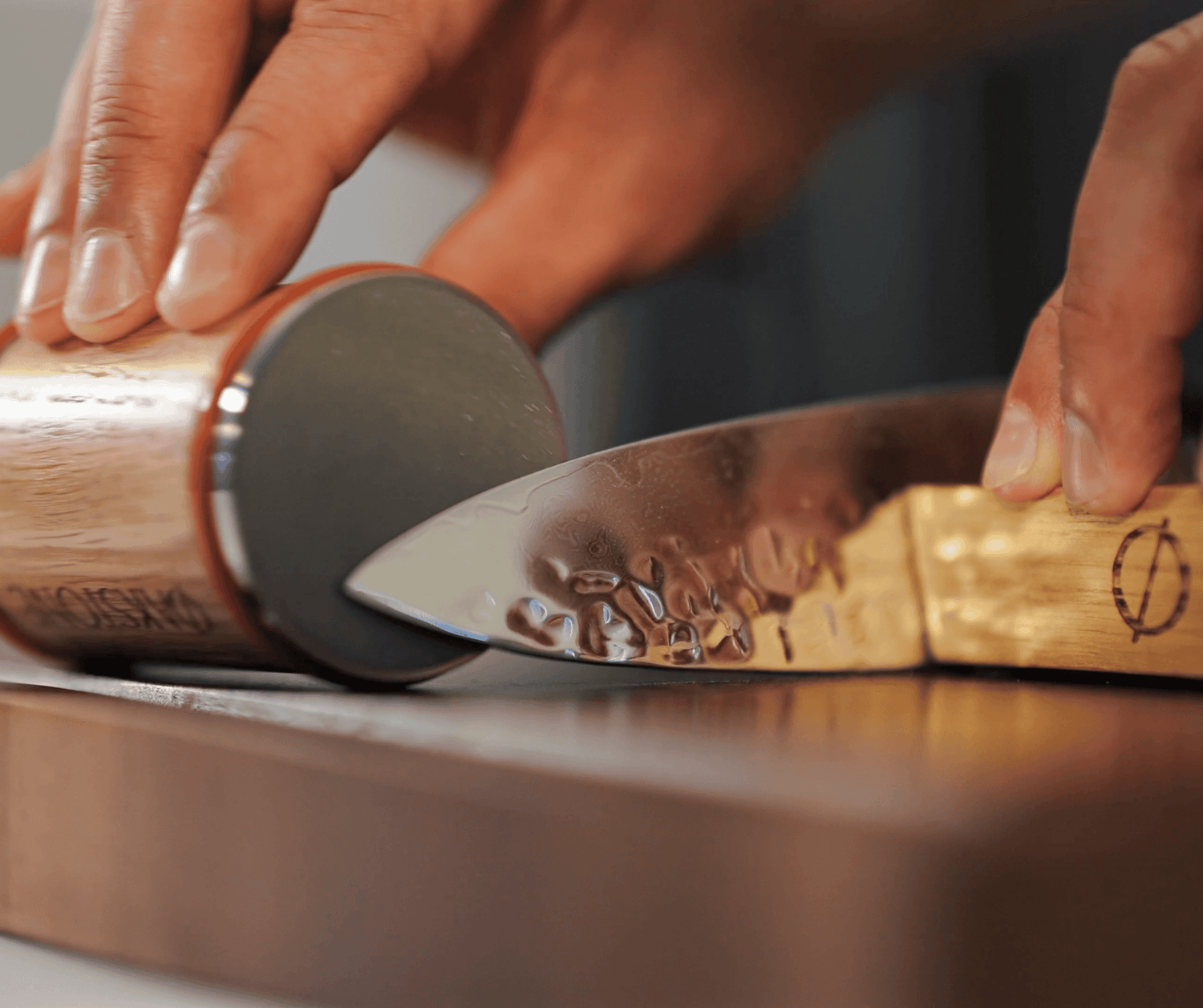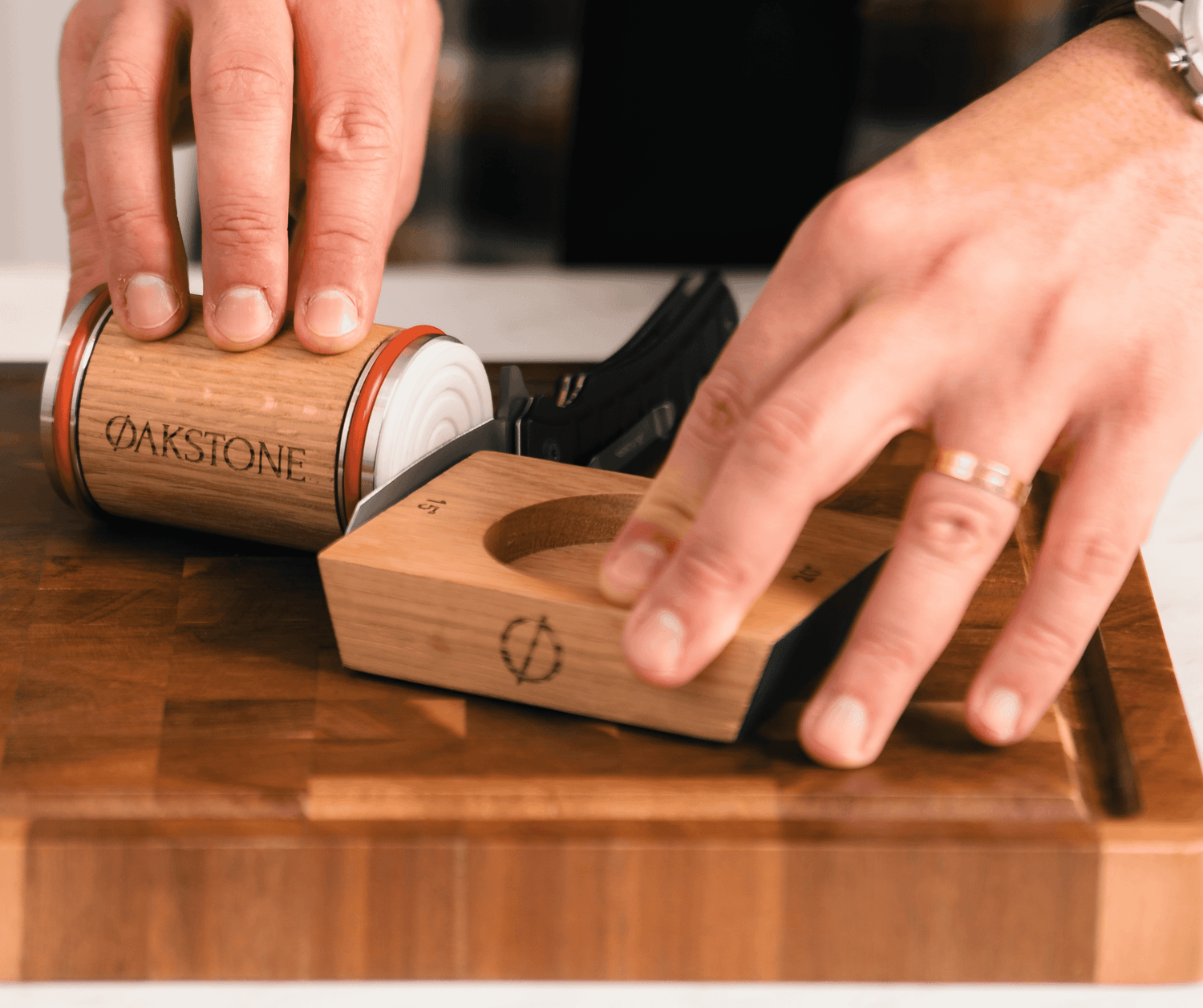Diamond vs. Tungsten Carbide: What's Really Sharpening Your Knives?
You’ve probably seen them: the small, v-shaped "pull-through" sharpeners that promise a sharp knife in just a few seconds. They’re convenient and cheap, but many experienced home cooks are left wondering why their knives seem to get damaged or dull again almost immediately.
The answer lies in the material doing the work. The difference between a lasting, precision edge and a quick, damaging one comes down to a simple battle of materials: the controlled grind of diamond versus the aggressive tear of tungsten carbide.
Understanding this difference is the key to choosing a sharpener that cares for your knives, rather than one that just rips them into shape.

The Aggressive Tear: How Tungsten Carbide Works
Most quick-fix, pull-through sharpeners use two small blades of tungsten carbide angled into a 'V'. When you pull your knife through, these hard blades scrape metal away from both sides of your knife's edge.
The Action: This is not a grinding or honing process; it's a forceful tearing or stripping of steel.
The Result: It creates a very rough, "micro-serrated" edge. This edge can feel sharp initially because the jagged teeth will bite into food, but these teeth are weak and will bend or break off very quickly, leaving the blade dull again. More importantly, this aggressive action removes far too much metal, which can permanently damage the profile of a quality knife over time.
The Precision Grind: How Diamond Abrasives Work
A premium sharpener, like the Oakstone roller, uses a disc coated in industrial diamond particles. Diamond is the hardest substance on earth, making it the perfect material for sharpening.
The Action: The thousands of tiny diamond particles act like a fine grinding wheel. They precisely and efficiently abrade the steel to create a new, clean, and perfectly angled edge.
The Result: This controlled grinding process removes only the microscopic amount of steel necessary. It creates a flawless foundation for a sharp edge without causing the stress or damage associated with tearing metal away.
The Finishing Touch: Why Ceramic is Essential
Creating a new edge is only step one. A truly great edge must be refined. After sharpening with the diamond disc, our #1000 ceramic disc comes into play.
The Action: The fine ceramic material acts as a hone, polishing the new edge, straightening it at a microscopic level, and cleanly removing the fragile "burr" (a wire of metal created during sharpening).
The Result: A smooth, strong, and highly polished edge that is not only razor-sharp but also durable and long-lasting.
The Diamond + Ceramic system is a complete, two-stage process that respects your knives. It first creates a perfect edge, then refines it to perfection - a world away from the one-step, brute-force approach of tungsten carbide.

The tearing action of tungsten carbide creates a very rough, jagged edge. These "micro-teeth" will aggressively bite into food, giving the illusion of sharpness. However, this edge is very weak and will break down almost immediately with use.
Sharpeners that use tungsten carbide for their abrasive action are generally too aggressive for quality knives and can lead to excessive wear over time. Pull-through sharpeners that use fine ceramic rods for simple honing are much gentler, but they cannot restore a truly dull blade.
In many cases, yes. It may take a few extra passes with the Oakstone's #400 diamond disc, but it can grind a new, clean, and precise V-shaped bevel onto the blade, effectively removing the rough, damaged edge left behind by the tungsten carbide.
"Better" depends on the user. Whetstones are fantastic but require significant skill to maintain a perfect angle. A diamond rolling sharpener provides the same high-quality abrasive benefits but uses a magnetic guide to lock in the angle, giving you a perfect, consistent result without the steep learning curve.
Ready to Earn Your Edge?
Get Sharpening Secrets & Members-Only Perks
The insights you need to make smarter kitchen decisions.
Ready to Earn Your Edge?
Get Sharpening Secrets & Members-Only Perks





